
BMW X7 vs Rivals: Spec Comparo
- Aug 5, 2019
- Views : 7767

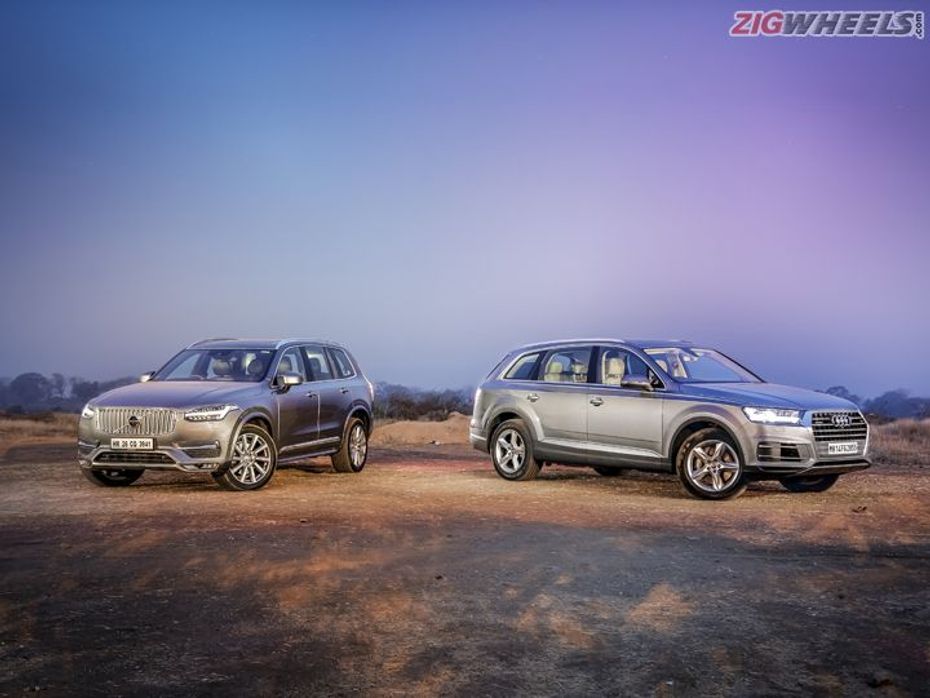
The Indian automotive market is currently teeming with SUVs, from affordable compact ones to the super luxurious ones. And it is no wonder that SUVs have evolved so well over the past decade or so. Volvo's all-new XC90 and the new Audi Q7 are offerings that are textbook representations of how this class of cars has matured over time.
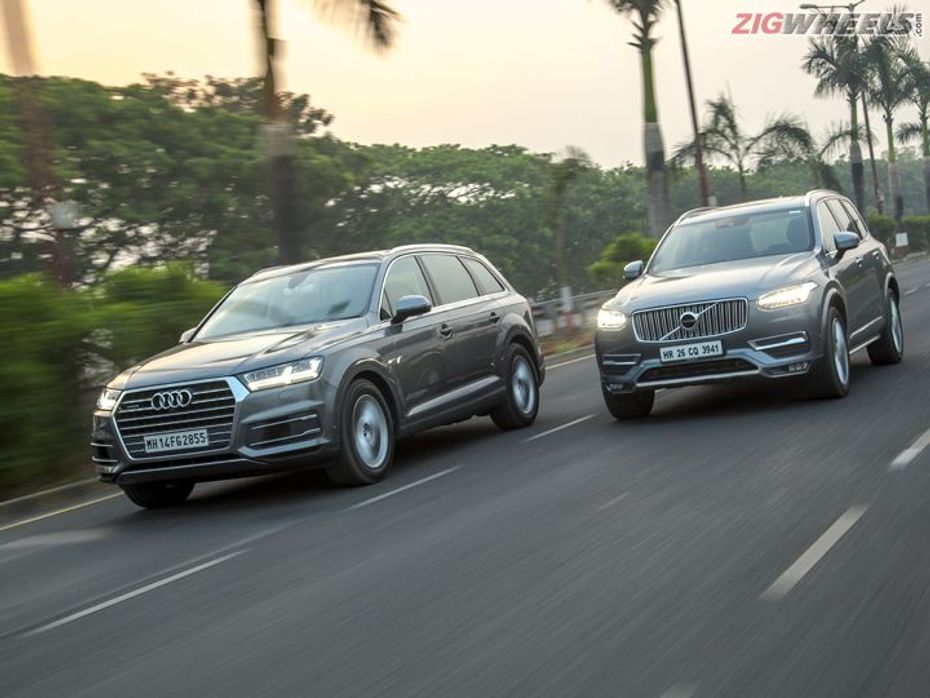
And when talking about German luxury SUVs, it’s hard to leave the Audi Q7 out. It has been India's favourite full-size luxury SUV after all, and the preferred choice of celebrities. The recently launched new generation Q7 sets new benchmarks in terms of luxury and quality, and is yet more affordable than its predecessor. It has been the segment leader for quite a while, but by the looks of the action in the luxury SUV space the new Q7 it will have to work harder to retain its title. With these two extremely competent offerings in the segment, we sure have a game on our hands.
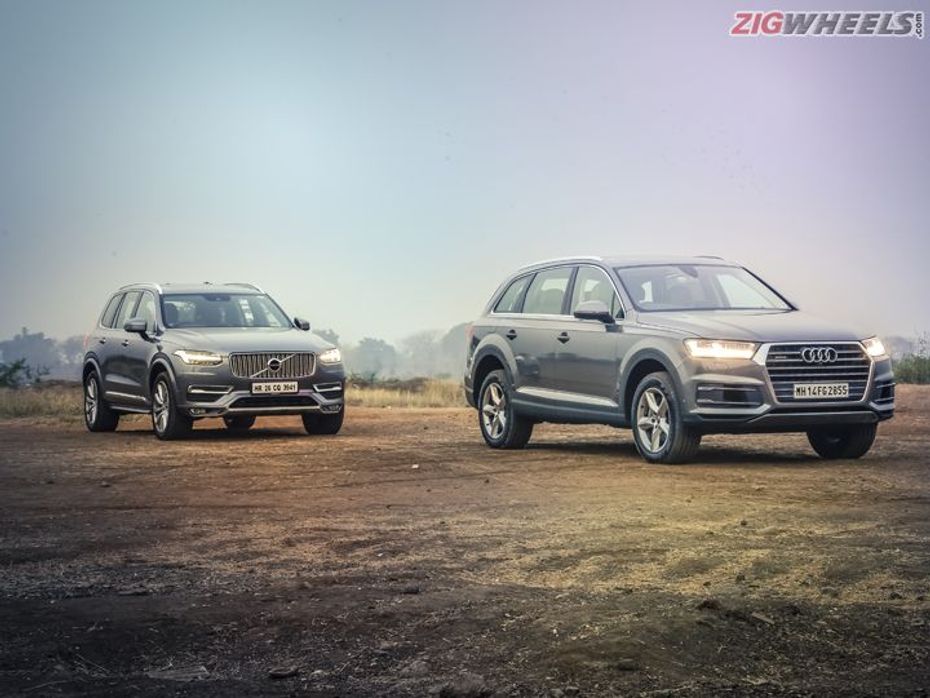
Exterior Design:
Luxury cars are a lot about head turning abilities and this statement best applies to luxury SUVs in the Indian context. In that regards, the new Volvo XC90 is quite a looker and is the first Volvo to flaunt the brand’s new design language. Right from the front grille with massive vertical slats, the slender headlights with the 'Thor's hammer' LED DRLs to the typical Volvo taillights, the XC90 pleases with its subtlety.
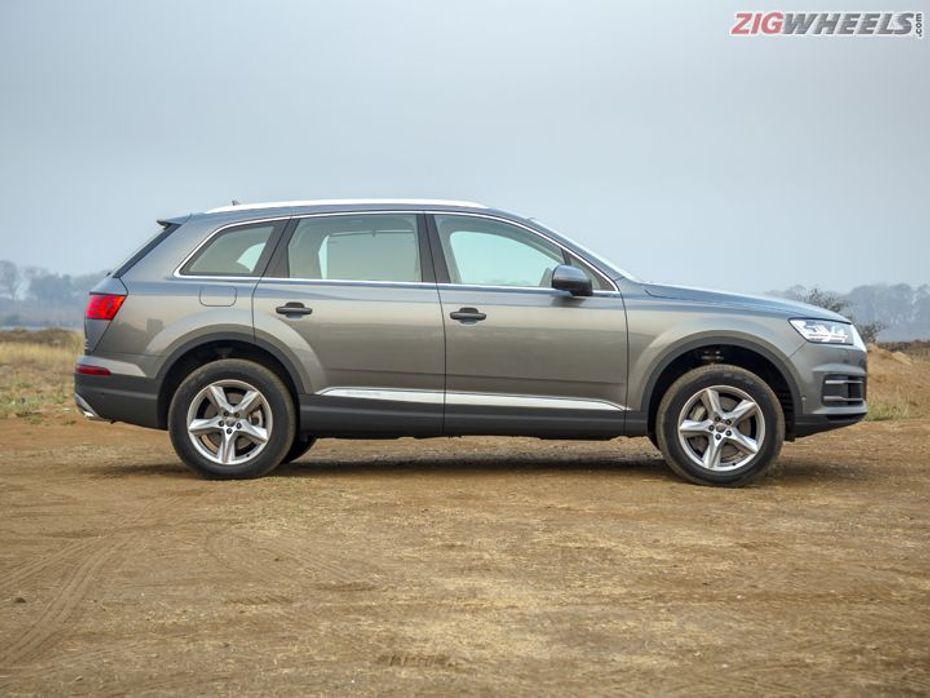
The Audi Q7 on the other hand is more of an evolution over the previous generation model. A quick glance will tell you that the Q7 was working out at the gym, and that has helped it lose all the bulk. While definitely sharper looking than before, it retains some cues from the previous generation model like the hexagonal front grille and narrow headlights. The edgy tailgate and smart looking taillights with dynamic directional indicators enhance the appeal of its rear end.
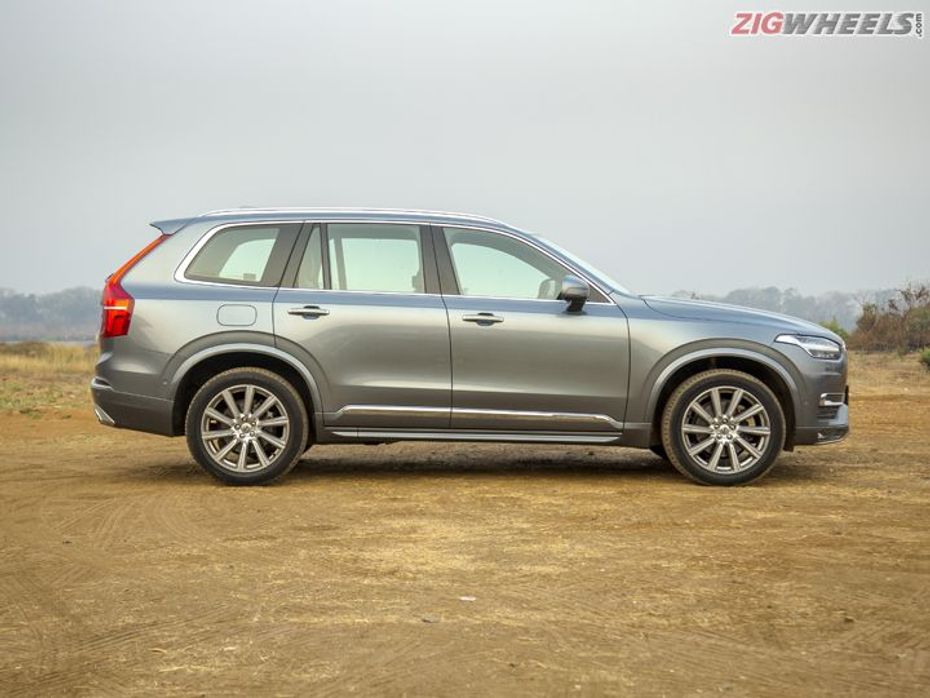
The new Q7 does look younger, but misses out on the butch stance of its predecessor. In fact the reduced proportions almost make it look estate-like. Moreover, the Q7 is over 5 metres long as compared to the XC90’s 4,950mm length, but it is the Volvo that looks larger and has greater road presence. The fact that the XC90 is an all-new design as opposed to the Q7 which retains the same silhouette as before also works in the Swedish car maker’s favour.

Interior and Space:
From cars that cost a crore, you would expect nothing short of top notch quality and in that regard both cars don’t disappoint. The difference though is in the treatment of the interiors.
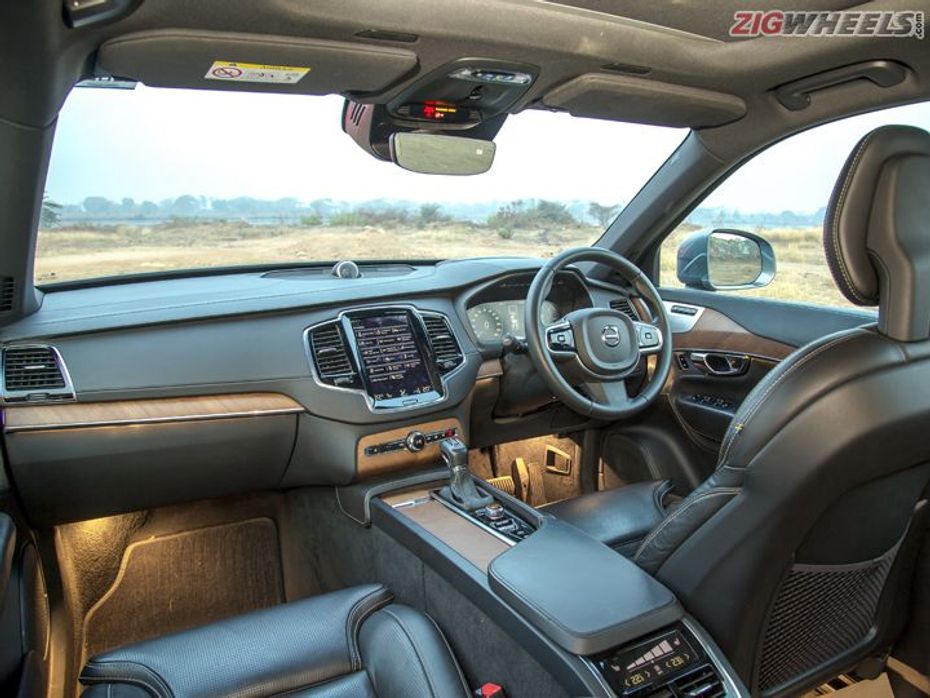
Volvo has given the XC90 a fresh and invigorating layout with a large screen in the centre that pretty much controls everything you’d possibly want to fidget with. The interface is extremely user friendly. The tablet-like touchscreen has been smartly angled such that it doesn’t reflect sunlight. Aside from the screen there are just a few basic buttons on the centre console which gives the XC90 an extremely clean look. We particularly loved unlacquered wood that has been used all round.
The Q7’s cabin on the other hand is extremely business-like. The combination of leather, brushed aluminum and wood has been used well to give the car an elegant look. However, switching from the XC90 the Q7 looks cluttered and busy. Faux air con vents stretch across the width of the dashboard, something we aren’t particularly fond of. Placed under the actual air con vents are nice looking dual-zone climate control knobs that also display the temperature. The Q7’s retractable screen sits at the top of the dashboard. For ease of access, the rotary knob that controls all settings has been placed within arm’s reach next to the gear lever.

In terms of comfort, seats in both SUVs are on par with each other. Front seats are well bolstered and support the thighs well but the same cannot be said about the middle row. For cars that are close to 5 metres in length good leg and knee room is a given but under thigh support for middle row passengers could have been better in both SUVs. The Audi is the wider of the two on the outside and it shows. Although it is wide enough to seat three abreast with ease, the large transmission tunnel eats into the comfort of the passenger sitting in the middle. Both cars have adjustable middle row seats to help find that compromise of space.
Getting in and out of the third row is a lot easier in the Audi than its rival in discussion. The German offering’s seat folds all the way forward for that ease of ingress but the XC90’s middle row just slides forward making it slightly more difficult. Once in, the Volvo offers a lot more comfort and feels roomier than the Q7 though. Weirdly, the seventh seat of the Q7 can only be used if you remove the spare tyre that sits vertically in the boot. This also eats up quite a bit of boot capacity. However, even without the spare wheel the XC90’s boot is considerably larger.

Features and Equipment:
Not that we need to say it, but both cars come loaded to the brim with gizmos. From LED headlights and leather interiors to electronically adjustable front seats and panoramic sun roofs, they they have all the features one could ask for. Four-zone climate control, cruise control, a powered tailgate, Bluetooth telephony and automatic park assist are some of the features common on both. Apart from these the XC90 also gets ventilated front seats, a head-up display and dedicated air con vents for third row passengers.
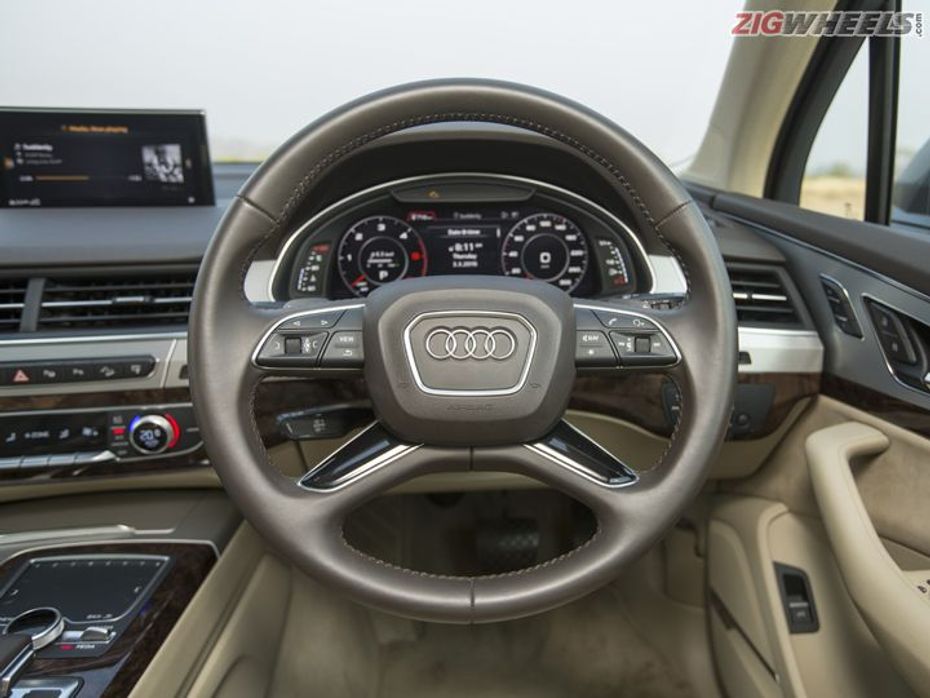
The Q7 covers up some ground with its electrically adjustable steering wheel and ambient lighting. The most useful feature on the Q7 though is the 360 degree parking camera, something the XC90 misses out on. The XC90 gets a brilliant sounding Bowers and Wilkins audio system with as many as 19 speakers, while the Audi Q7 gets an equally crisp Bose unit to flaunt, ensuring both are on par with each other when it comes to playing your choice of music.

Engines and performance:
This is where the Q7 outshines its Scandinavian rival. The Audi comes with a 3.0-litre V6 engine that produces 249PS of power. It might not seem a huge leap over the Volvo XC90’s 225PS that it makes from a 2.0-litre 4-cylinder motor but the way the power is delivered in the Q7 is what makes a world of a difference. And that is mainly for the fact that the Q7 offers its peak power at revs as low as 2,910rpm as opposed to the XC90’s 4,250rpm. The icing on the cake for the Audi is its torque output of a whopping 600Nm compared to the Volvo’s 470Nm.
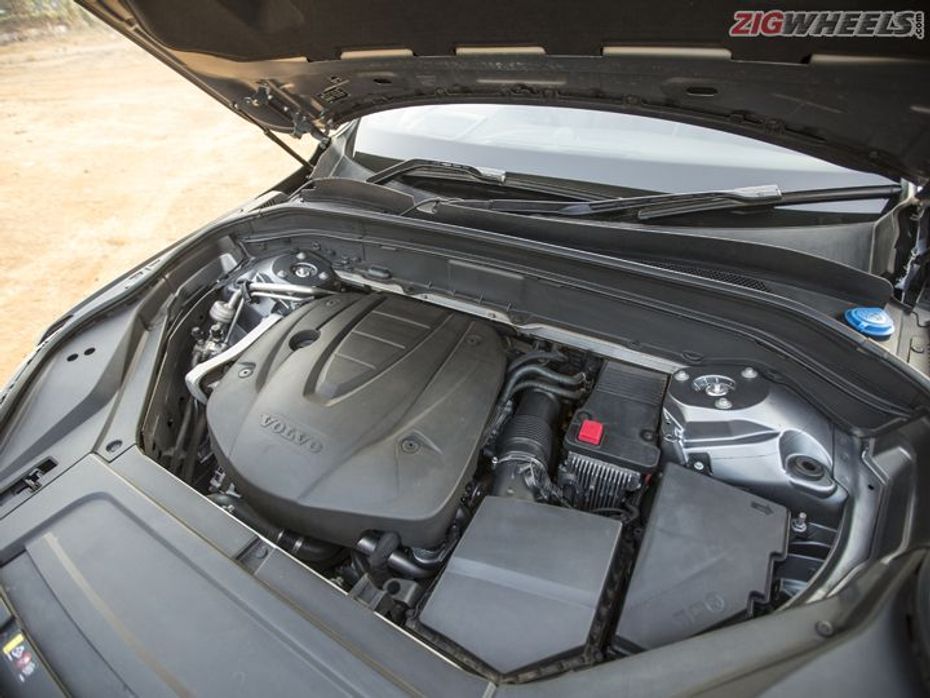
The Q7’s engine feels more eager and the car comfortably pulls at low to mid revs thanks to its wider power and torque range. Its the new Q7's refinement that's absolutely commendable though. No matter where the needle points on the tachometer, the engine remains absolutely relaxed. The 8-speed ZF-sourced gearbox feels smoother than before too. When at cruising speeds, the gearbox shifts-up swiftly to keep vibration restricted. But if you are the spirited kind who likes to take matters in their own hands, you can always make use of the paddle shifters or hold revs for longer to extract the best out of the motor in Sport mode.
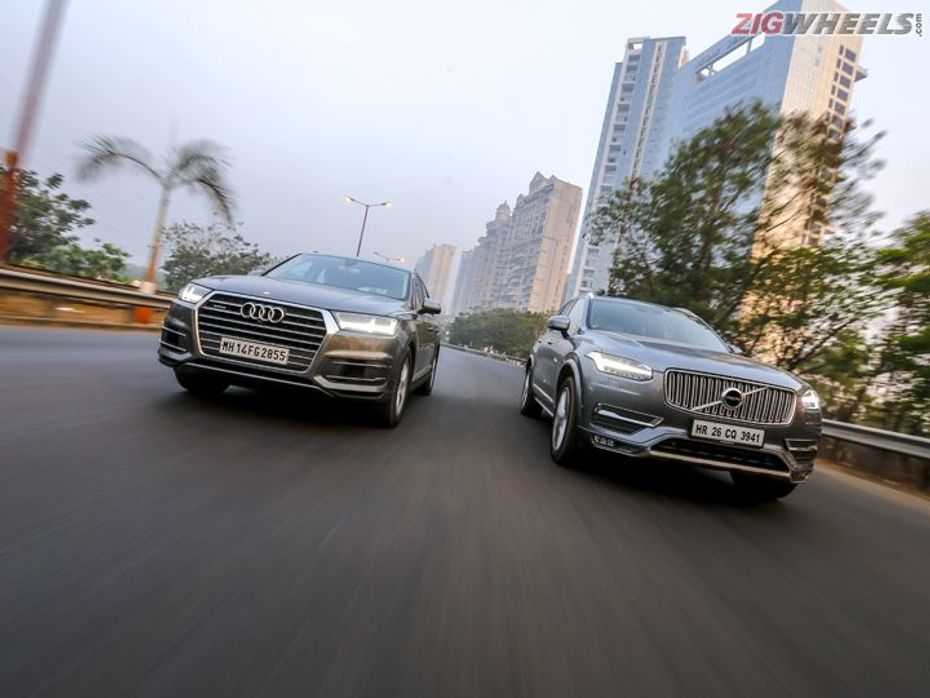
As opposed to the Q7, the XC90 isn’t quite the car you would buy for its performance. The fact that it makes its peak power and torque relatively higher up the rev range makes it kind of inept in comparison. Once in its mid-range the car does offer the punchy performance you would hope for but it just doesn’t seem as energetic as its German rival towards the top of its rev band. While the engine and performance isn’t bad in its own right, bringing the Q7 into the picture changes the equation completely. In terms of refinement too, the 4-cylinder unit doesn’t feel as smooth as the Q7's V6 and starts to get noisy as revs build up. The XC90 too employs an 8-speed automatic transmission which works well for everyday jaunts but drive the it enthusiastically and you feel the need for smoother, faster shifts.
The Q7 tips the scale at 2,330kg which is 200kg more than its rival, but the surplus power and torque are more than enough to make up for the additional weight. In fact, the Q7 is even quicker accelerating to 100kmph from standstill. While the Audi was able to achieve the feat in 7.1 seconds, the Volvo XC90 took a fraction above 9 seconds.
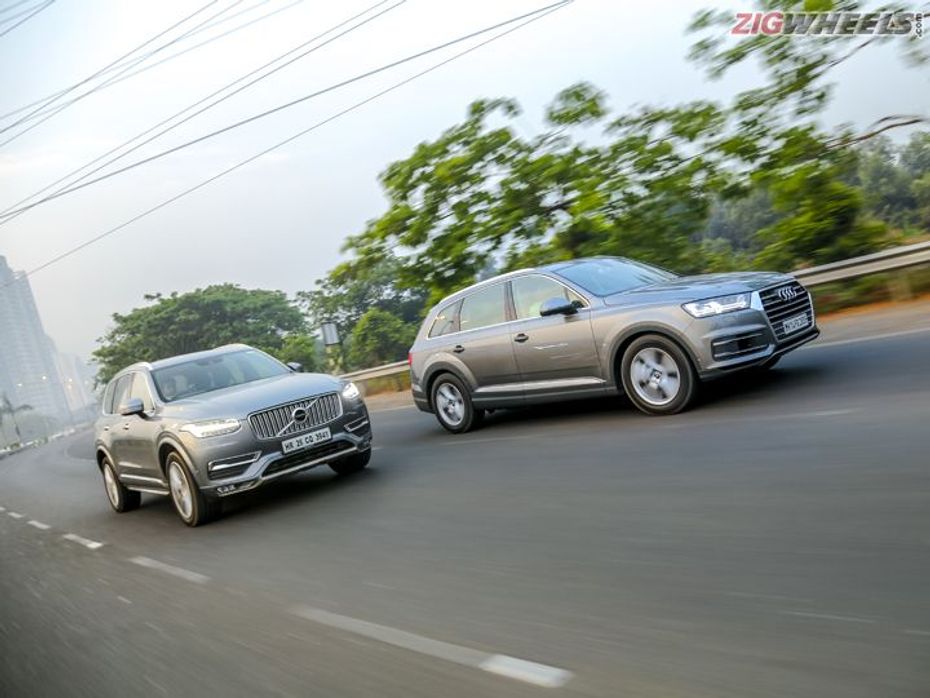
Ride and Ease of Driving:
The Q7 doesn’t feel very big to drive from behind the wheel despite its length. The low-set dashboard makes for good all round visibility and then of course you have the 360 degree camera to make parking it a piece of cake, the only challenge then will be finding a parking spot. The steering is light and makes maneuvering through traffic easy. The soft suspension works well in absorbing bumps and potholes however the larger undulations might just seep into the cabin. But what impressed us the most was the Q7's noise insulation inside the cabin. There is barely any wind or tyre noise inside which makes the overall driving experience calm and less tiring. The only chink in the Q7’s armour is the vertical movement you experience over bumpy road surfaces which makes the car feel unsettled.

High speed stability in the Volvo is a lot better than the Audi. When cruising on a highway, the Swedish SUV goes flat over uneven road surfaces thereby inspiring better confidence. At lower speeds in the city though, the XC90’s stiff suspension means an unsettled ride over bad roads. Keeping in mind the condition of some of our roads, the XC90’s 267mm ground clearance leaves little to worry about.
A downer in the Volvo is noise inside the cabin, it just doesn’t feel as quiet and comforting as the Q7. Due to the high-set dash, the Volvo XC90 also feels a lot bigger than the Audi Q7 from behind the wheel despite being smaller in size. This makes it driving it around the city a tricky affair, apart from which it also misses out on 360 degree camera.
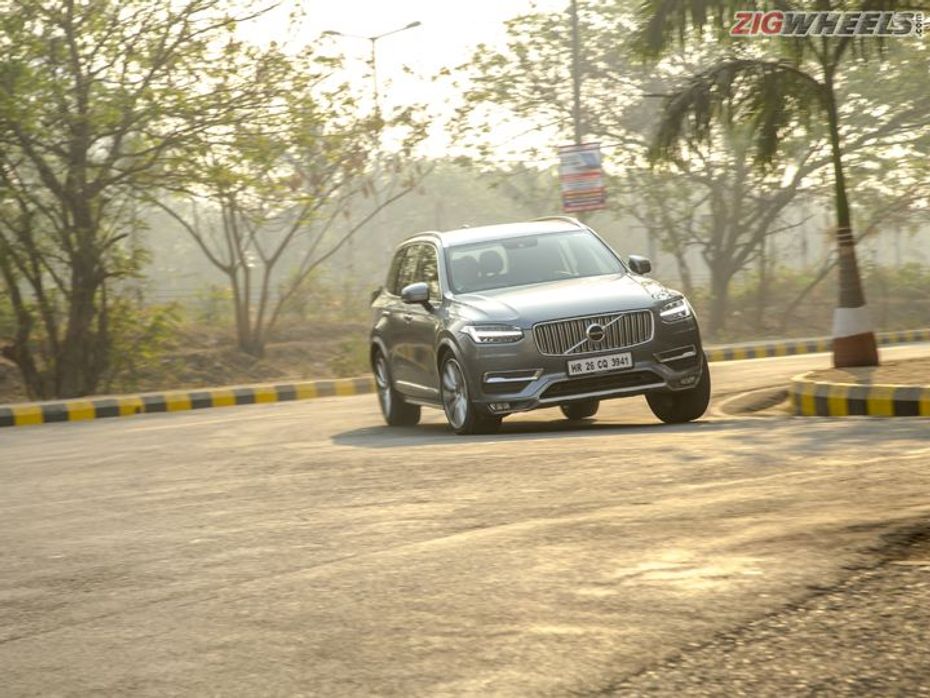
Handling and Braking:
Switch to Dynamic mode on the Audi Drive Select system and the Q7 feels quite sporty. The suspension stiffens up and the steering weighs up further which results in superior handling dynamics. We would have loved it if the wheel felt a bit more direct, would have given more confidence to push the Q7 harder. However, once you get past the artificial steering feel, the car changes direction with such ease that you might just mistake it for a sedan. Body roll is well controlled which further helps while driving enthusiastically but show the car a mid-corner bump and it might just get a little ill at ease.

The XC90’s stiffer suspension setup and more responsive steering feel would make you believe that it will take on corners with more confidence than the Q7. Surprisingly, that isn’t quite the case. There is quite a bit of body roll which plays spoil sport while taking on a series of bends making it that much more laborious to make quick directional changes. But the beauty of the XC90’s setup is that it doesn’t feel unsettled when it encounters mid-corner undulations. Stopping power of both the cars is pretty impressive especially for their size.
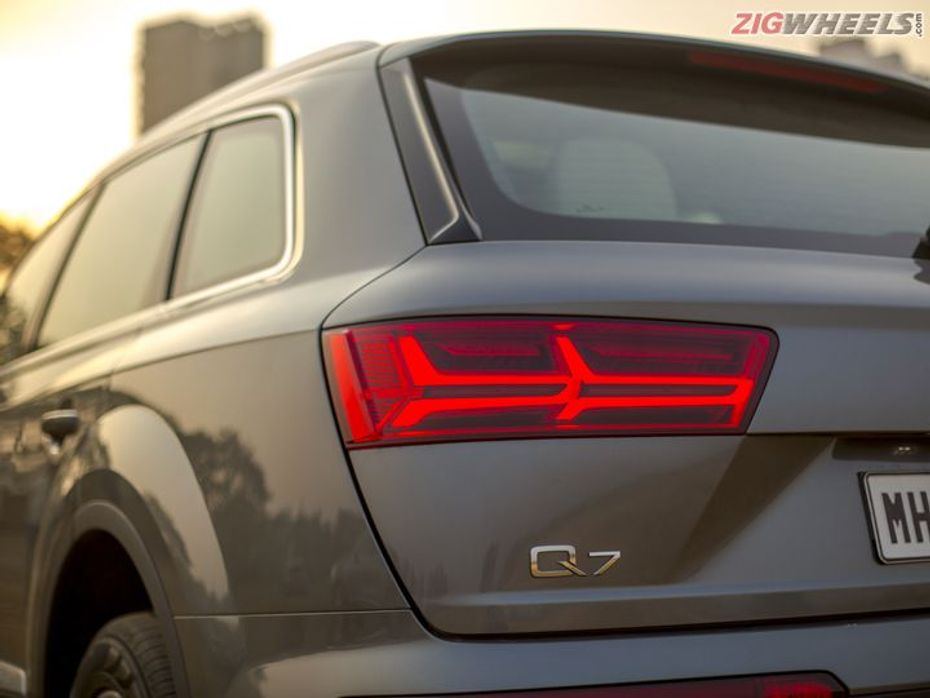
Price and Fuel Efficiency:
Not that it matters much for someone buying a car in this segment but both manufacturers have worked towards making their cars more efficient. The Q7 as well as the XC90 comes with engine start-stop function and other such efficiency boosting gadgetry. But it is the Volvo XC90 that trumps the Audi Q7 in this regard. The Swedish offering claims an efficiency of 17.2kmpl as opposed to the German’s 14.75kmpl. However, considering that the Audi is a V6 and makes more power and torque than the XC90, the equation is fairly balanced.

As far as pricing is concerned, both cars cost more or less the same. The top-end Q7 in the 45TDI Technology Pack trim is priced at Rs 77.50 lakh, while the XC90’s top-spec Inscription Luxury variant costs Rs 77.90 lakh (prices ex-showroom Delhi).
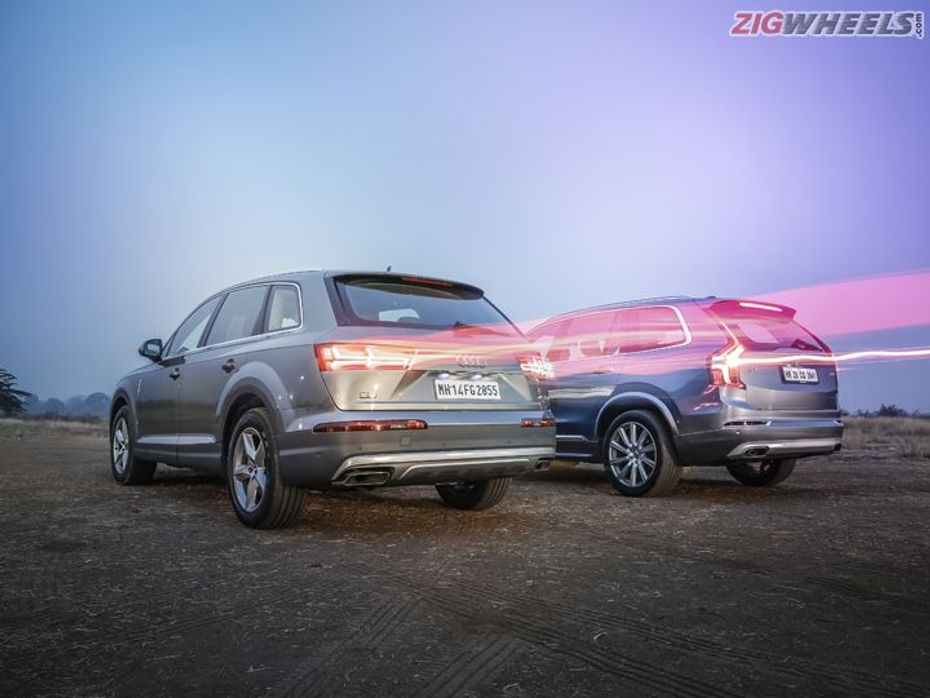
Verdict:
New Audi Q7: rating_4.5_rating
New Volvo XC90: rating_4.0_rating
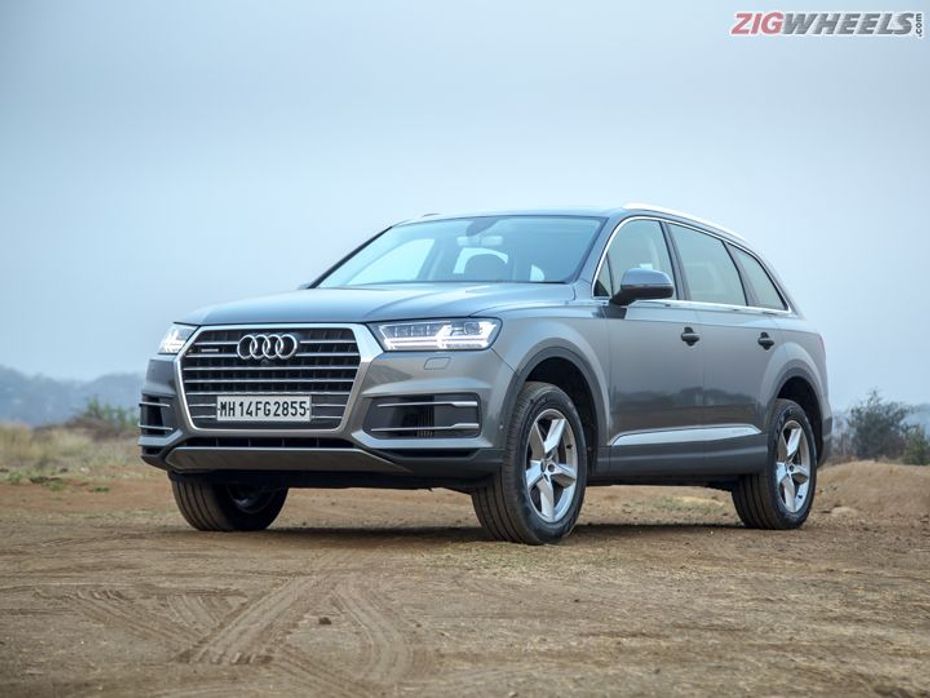
This battle between Volvo XC90 and the Audi Q7 has been quite a nail biting one. The Volvo offering has earned accolades across the globe and for good reason. Its overall design is absolutely beautiful, the cabin is fresh yet clean, and it comes loaded with features. Although engine and performance isn’t the XC90’s strongest point in this comparison, it scores fairly well in the ride and handling department. But what impressed us the most was how well the Volvo works as a 7-seater, something that the Audi found difficult to achieve. It is just the kind of product Volvo needed to help change its brand perception.

Although the Q7 loses some ground in looks, interior and space, the car more than makes up for it in terms of mechanicals. The V6 unit under the bonnet is extremely refined and punchy. In ride quality and ease of driving too, it inches ahead of the rival in discussion and is clearly the better car to drive. Moreover, it is even priced cheaper than the Volvo, albeit by a whisker. To sum it up, as an overall product, the new Audi Q7 comes out stronger in this battle.

BMW X7 vs Rivals: Spec Comparo

Volvo XC90 vs Mercedes-Benz GL-Class vs BMW X5 vs Audi Q7 vs Land...

Audi Q7 Black Edition Launched; Limited to Just 100 Units

Audi Q3 And Q7 Get Design Edition Variants

Audi Q7 Gets A Petrol Engine

Audi Q7 40 TFSI (Petrol) Launch On September 1

Audi Q7 And Audi A6 'Design Edition' Launched

Audi SQ7 TDI unveiled, India launch by mid-2016

New Audi Q7 launched in India at Rs 72 lakh

New Audi Q7 to be launched in India on December 10
 Volvo XC90
Volvo XC90
India's largest automotive community
 Audi A4
Rs. 46.99 Lakh
Audi A4
Rs. 46.99 Lakh
 Audi Q7
Rs. 88.70 Lakh
Audi Q7
Rs. 88.70 Lakh
 Audi Q5
Rs. 66.99 Lakh
Audi Q5
Rs. 66.99 Lakh
 Audi Q3
Rs. 44.99 Lakh
Audi Q3
Rs. 44.99 Lakh
 Audi A6
Rs. 65.72 Lakh
Audi A6
Rs. 65.72 Lakh
 Land Rover Range Rover
Rs. 2.36 Crore
Land Rover Range Rover
Rs. 2.36 Crore
 Volvo XC90
Rs. 1.00 Crore
Volvo XC90
Rs. 1.00 Crore
 Mercedes-Benz GLA
Rs. 50.80 Lakh
Mercedes-Benz GLA
Rs. 50.80 Lakh
 Toyota Vellfire
Rs. 1.22 Crore
Toyota Vellfire
Rs. 1.22 Crore
 Porsche 911
Rs. 1.98 Crore
Porsche 911
Rs. 1.98 Crore